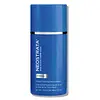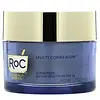What's inside
What's inside
 Key Ingredients
Key Ingredients

 Benefits
Benefits

 Concerns
Concerns

 Ingredients Side-by-side
Ingredients Side-by-side

Water
Skin ConditioningAcetyl Glucosamine
Skin ConditioningCyclopentasiloxane
EmollientTriethyl Citrate
MaskingCetearyl Alcohol
EmollientC12-15 Alkyl Benzoate
AntimicrobialButyrospermum Parkii Butter
Skin ConditioningGlyceryl Stearate
EmollientCyclohexasiloxane
EmollientGlycerin
HumectantIsocetyl Stearoyl Stearate
EmollientDimethicone
EmollientEthoxydiglycol
HumectantPEG-100 Stearate
Polymethylsilsesquioxane
Nylon-12
Isostearic Acid
CleansingTocopheryl Acetate
AntioxidantPalmitoyl Glycine
CleansingMalus Domestica Fruit Cell Culture Extract
Skin ConditioningHydrogenated Palm Kernel Glycerides
EmollientHydrogenated Palm Glycerides
EmollientDimethiconol
EmollientIsopropyl Myristate
EmollientCaprylyl Glycol
EmollientLecithin
EmollientPEG-40 Stearate
EmulsifyingCeteareth-20
CleansingCarbomer
Emulsion StabilisingXanthan Gum
EmulsifyingPentaerythrityl Tetra-Di-T-Butyl Hydroxyhydrocinnamate
AntioxidantSodium Bisulfite
AntioxidantDisodium EDTA
Ammonium Hydroxide
BufferingChlorphenesin
AntimicrobialPhenoxyethanol
PreservativeEthylene Brassylate
MaskingMethyldihydrojasmonate
MaskingIsobutyl Methyl Tetrahydropyranol
MaskingMethyl Decenol
MaskingCaramel
Cosmetic ColorantCI 19140
Cosmetic ColorantWater, Acetyl Glucosamine, Cyclopentasiloxane, Triethyl Citrate, Cetearyl Alcohol, C12-15 Alkyl Benzoate, Butyrospermum Parkii Butter, Glyceryl Stearate, Cyclohexasiloxane, Glycerin, Isocetyl Stearoyl Stearate, Dimethicone, Ethoxydiglycol, PEG-100 Stearate, Polymethylsilsesquioxane, Nylon-12, Isostearic Acid, Tocopheryl Acetate, Palmitoyl Glycine, Malus Domestica Fruit Cell Culture Extract, Hydrogenated Palm Kernel Glycerides, Hydrogenated Palm Glycerides, Dimethiconol, Isopropyl Myristate, Caprylyl Glycol, Lecithin, PEG-40 Stearate, Ceteareth-20, Carbomer, Xanthan Gum, Pentaerythrityl Tetra-Di-T-Butyl Hydroxyhydrocinnamate, Sodium Bisulfite, Disodium EDTA, Ammonium Hydroxide, Chlorphenesin, Phenoxyethanol, Ethylene Brassylate, Methyldihydrojasmonate, Isobutyl Methyl Tetrahydropyranol, Methyl Decenol, Caramel, CI 19140
Water
Skin ConditioningPropylene Glycol
HumectantGlycerin
HumectantIsononyl Isononanoate
EmollientDimethicone
EmollientSteareth-2
EmulsifyingEthylhexyl Palmitate
EmollientStyrene
PerfumingButyrospermum Parkii Butter
Skin ConditioningVinyl Dimethicone/Methicone Silsesquioxane Crosspolymer 2%
Butyl Methoxydibenzoylmethane
UV AbsorberHomosalate 4%
Skin ConditioningOctocrylene 4%
UV AbsorberBenzophenone-3 2%
UV AbsorberHexylresorcinol
AntimicrobialSteareth-21
CleansingPeucedanum Graveolens Extract
TonicRubus Fruticosus Leaf Extract
MaskingTocopheryl Acetate
AntioxidantAscorbyl Glucoside
AntioxidantSclerotium Gum
Emulsion StabilisingStearyl Alcohol
EmollientPEG-8 Laurate
EmulsifyingAcrylates Copolymer
Ammonium Acryloyldimethyltaurate/Vp Copolymer
Behenyl Alcohol
EmollientArachidyl Alcohol
EmollientMaltodextrin
AbsorbentXanthan Gum
EmulsifyingLinseed Acid
CleansingDimethicone Crosspolymer
Emulsion StabilisingCetyl Alcohol
EmollientButylene Glycol
HumectantSodium Dodecylbenzenesulfonate
CleansingPhenoxyethanol
PreservativeChlorphenesin
AntimicrobialSodium Carbonate
BufferingSodium Hydroxide
BufferingDisodium EDTA
Ethylhexylglycerin
Skin ConditioningParfum
MaskingWater, Propylene Glycol, Glycerin, Isononyl Isononanoate, Dimethicone, Steareth-2, Ethylhexyl Palmitate, Styrene, Butyrospermum Parkii Butter, Vinyl Dimethicone/Methicone Silsesquioxane Crosspolymer 2%, Butyl Methoxydibenzoylmethane, Homosalate 4%, Octocrylene 4%, Benzophenone-3 2%, Hexylresorcinol, Steareth-21, Peucedanum Graveolens Extract, Rubus Fruticosus Leaf Extract, Tocopheryl Acetate, Ascorbyl Glucoside, Sclerotium Gum, Stearyl Alcohol, PEG-8 Laurate, Acrylates Copolymer, Ammonium Acryloyldimethyltaurate/Vp Copolymer, Behenyl Alcohol, Arachidyl Alcohol, Maltodextrin, Xanthan Gum, Linseed Acid, Dimethicone Crosspolymer, Cetyl Alcohol, Butylene Glycol, Sodium Dodecylbenzenesulfonate, Phenoxyethanol, Chlorphenesin, Sodium Carbonate, Sodium Hydroxide, Disodium EDTA, Ethylhexylglycerin, Parfum
 Reviews
Reviews

Ingredients Explained
These ingredients are found in both products.
Ingredients higher up in an ingredient list are typically present in a larger amount.
This ingredient is also known as shea butter. It is an effective skin hydrator and emollient.
Emollients help soothe and soften your skin. It does this by creating a protective film on your skin. This barrier helps trap moisture and keeps your skin hydrated. Emollients may be effective at treating dry or itchy skin.
Shea butter is rich in antioxidants. Antioxidants help fight free-radicals, or molecules that may harm the body. It is also full of fatty acids including stearic acid and linoleic acid. These acids help replenish the skin and keep skin moisturized.
While Shea Butter has an SPF rating of about 3-4, it is not a sunscreen replacement.
Shea butter may not be fungal acne safe. We recommend speaking with a professional if you have any concerns.
Learn more about Butyrospermum Parkii ButterChlorphenesin is a synthetic preservative. It helps protect a product against bacteria in order to extend shelf life. In most cases, Chlorphenesin is paired with other preservatives such as phenoxyethanol and caprylyl glycol.
Chlorphenesin is a biocide. This means it is able to help fight the microorganisms on our skin. It is also able to fight odor-releasing bacteria.
Chlorphenesin is soluble in both water and glycerin.
Studies show Chlorphenesin is easily absorbed by our skin. You should speak with a skincare professional if you have concerns about using Chlorphenesin.
Learn more about ChlorphenesinDimethicone is a type of synthetic silicone created from natural materials such as quartz.
What it does:
Dimethicone comes in different viscosities:
Depending on the viscosity, dimethicone has different properties.
Ingredients lists don't always show which type is used, so we recommend reaching out to the brand if you have questions about the viscosity.
This ingredient is unlikely to cause irritation because it does not get absorbed into skin. However, people with silicone allergies should be careful about using this ingredient.
Note: Dimethicone may contribute to pilling. This is because it is not oil or water soluble, so pilling may occur when layered with products. When mixed with heavy oils in a formula, the outcome is also quite greasy.
Learn more about DimethiconeDisodium EDTA plays a role in making products more stable by aiding other preservatives.
It is a chelating agent, meaning it neutralizes metal ions that may be found in a product.
Disodium EDTA is a salt of edetic acid and is found to be safe in cosmetic ingredients.
Learn more about Disodium EDTAGlycerin is already naturally found in your skin. It helps moisturize and protect your skin.
A study from 2016 found glycerin to be more effective as a humectant than AHAs and hyaluronic acid.
As a humectant, it helps the skin stay hydrated by pulling moisture to your skin. The low molecular weight of glycerin allows it to pull moisture into the deeper layers of your skin.
Hydrated skin improves your skin barrier; Your skin barrier helps protect against irritants and bacteria.
Glycerin has also been found to have antimicrobial and antiviral properties. Due to these properties, glycerin is often used in wound and burn treatments.
In cosmetics, glycerin is usually derived from plants such as soybean or palm. However, it can also be sourced from animals, such as tallow or animal fat.
This ingredient is organic, colorless, odorless, and non-toxic.
Glycerin is the name for this ingredient in American English. British English uses Glycerol/Glycerine.
Learn more about GlycerinPhenoxyethanol is a preservative that has germicide, antimicrobial, and aromatic properties. Studies show that phenoxyethanol can prevent microbial growth. By itself, it has a scent that is similar to that of a rose.
It's often used in formulations along with Caprylyl Glycol to preserve the shelf life of products.
Tocopheryl Acetate is AKA Vitamin E. It is an antioxidant and protects your skin from free radicals. Free radicals damage the skin by breaking down collagen.
One study found using Tocopheryl Acetate with Vitamin C decreased the number of sunburned cells.
Tocopheryl Acetate is commonly found in both skincare and dietary supplements.
Learn more about Tocopheryl AcetateWater. It's the most common cosmetic ingredient of all. You'll usually see it at the top of ingredient lists, meaning that it makes up the largest part of the product.
So why is it so popular? Water most often acts as a solvent - this means that it helps dissolve other ingredients into the formulation.
You'll also recognize water as that liquid we all need to stay alive. If you see this, drink a glass of water. Stay hydrated!
Learn more about WaterXanthan gum is used as a stabilizer and thickener within cosmetic products. It helps give products a sticky, thick feeling - preventing them from being too runny.
On the technical side of things, xanthan gum is a polysaccharide - a combination consisting of multiple sugar molecules bonded together.
Xanthan gum is a pretty common and great ingredient. It is a natural, non-toxic, non-irritating ingredient that is also commonly used in food products.
Learn more about Xanthan Gum